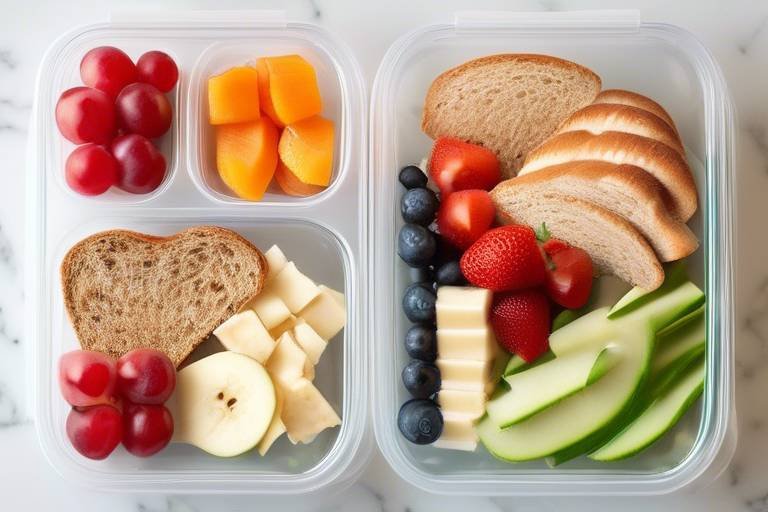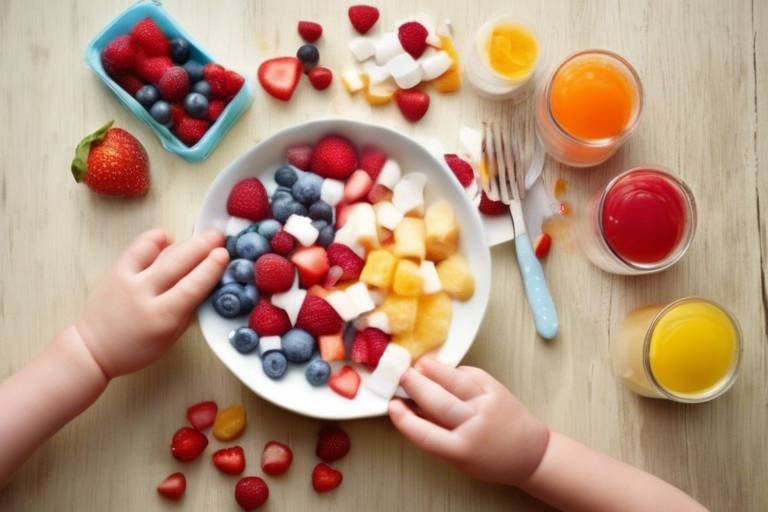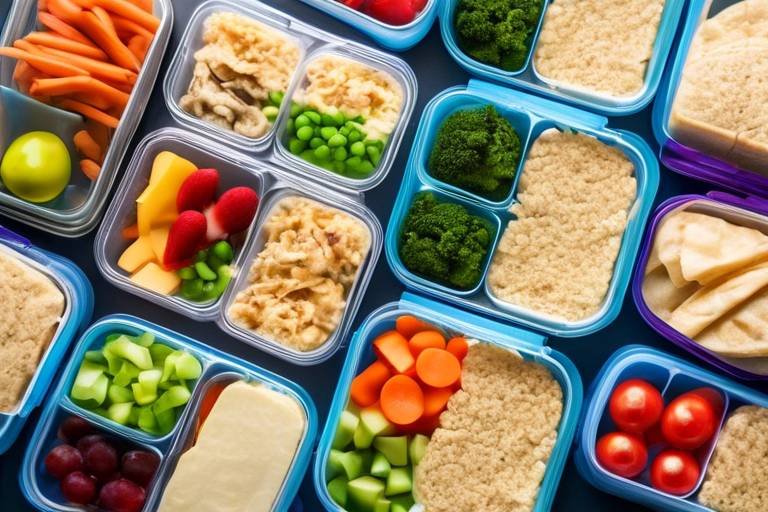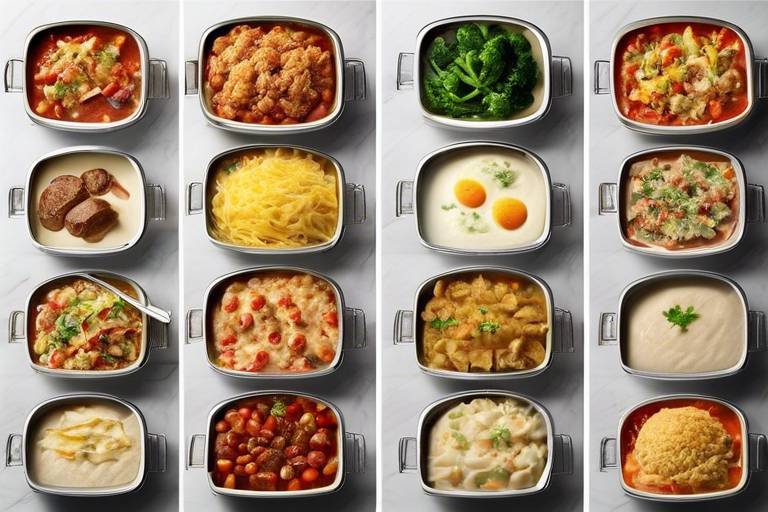How to Prep Healthier Lunches for Your Kids
As parents, we often find ourselves in a whirlwind of activities, juggling work, chores, and the endless quest to keep our kids happy and healthy. One of the biggest challenges is preparing nutritious lunches that our children will actually eat. Let’s face it, kids can be picky eaters, and making their meals appealing is no small feat! But fear not! This article explores practical strategies and creative ideas for preparing nutritious and appealing lunches for children, ensuring they receive the essential nutrients needed for their growth and development.
Children have unique nutritional requirements that differ from adults. They need a mix of vitamins, minerals, proteins, carbohydrates, and fats to fuel their busy little bodies and growing minds. Think of it like a car; if you don’t put the right fuel in, it won’t run efficiently! Essential nutrients such as calcium for strong bones, iron for energy, and vitamins for immune support are crucial. Understanding these needs can help you make informed choices when packing their lunches. So, what exactly do kids need? Here’s a quick breakdown:
| Nutrient | Importance | Sources |
|---|---|---|
| Protein | Supports growth and muscle development | Chicken, beans, yogurt |
| Calcium | Strengthens bones and teeth | Milk, cheese, leafy greens |
| Iron | Boosts energy and cognitive function | Red meat, lentils, spinach |
| Vitamins | Enhances immune system and overall health | Fruits, vegetables, whole grains |
Creating balanced meals involves incorporating a variety of food groups. It’s all about harmony on the plate! A well-rounded lunch should include proteins, carbohydrates, and healthy fats. For instance, think of a sandwich made with whole-grain bread (carbs), turkey (protein), and avocado (healthy fat). To make it even more exciting, throw in a side of carrot sticks and some hummus for dipping. By planning ahead, you can ensure your kids are not just filling their tummies but also getting the nutrients they need.
Fruits and vegetables are vital for a child's diet. They provide essential vitamins, minerals, and fiber. But how do you get your kids to eat them? It can be a challenge, but with a little creativity, you can turn these healthy options into fun and appealing additions to their lunches. For example, cut fruits into fun shapes using cookie cutters or create a colorful veggie rainbow in their lunchbox. The more visually appealing the food, the more likely they are to dive in!
Engaging children with fun shapes and presentations can encourage them to eat more fruits and vegetables. Here are some playful ideas:
- Fruit Skewers: Thread pieces of fruit onto skewers for a fun, grab-and-go snack.
- Veggie Faces: Use slices of cucumbers, cherry tomatoes, and olives to create silly faces on a plate.
- Colorful Wraps: Use whole grain tortillas to wrap colorful veggies and proteins, making a visually appealing meal.
Using seasonal fruits and vegetables can enhance flavor and nutrition. Seasonal produce is often fresher, tastier, and packed with nutrients. Plus, it can be more affordable! For example, in the summer, you can enjoy juicy berries and crisp cucumbers, while fall brings delicious apples and squash. By choosing seasonal options, you not only support local farmers but also introduce your kids to a variety of flavors throughout the year.
Snacks play a crucial role in a child's diet. Instead of the usual chips or sugary treats, consider healthier alternatives that can be included in their lunchboxes. Think of snacks as mini-meals that should also be balanced. Some great options include:
- Yogurt with Berries: A great source of protein and antioxidants.
- Trail Mix: A mix of nuts, seeds, and dried fruits for energy.
- Whole Grain Crackers: Pair with cheese or nut butter for a satisfying crunch.
Getting kids involved in the meal preparation process can foster healthy eating habits. When children participate in making their lunches, they are more likely to eat what they’ve helped create. So, roll up your sleeves and get them in the kitchen! Let them wash fruits, mix ingredients, or even choose what goes into their lunchboxes. This not only teaches them valuable skills but also gives them a sense of ownership over their meals.
Introducing basic cooking skills to children can empower them to make healthier choices. Simple tasks such as washing vegetables, spreading peanut butter, or assembling a sandwich can be fun and educational. Start small and gradually introduce more complex tasks as they gain confidence. Remember, the kitchen is a great place for learning!
Allowing children to express their creativity in meal prep can make healthy eating more enjoyable. Encourage them to come up with their own lunch combinations. Maybe they want to create a “DIY taco” with their favorite toppings or a “make-your-own mini pizza” with whole-grain bases. The possibilities are endless, and the more they can experiment, the more likely they are to enjoy their meals.
Q: How can I make sure my child is getting enough nutrients?
A: Focus on a variety of foods across all food groups. Include proteins, whole grains, fruits, and vegetables in their meals to ensure a balanced diet.
Q: What are some quick lunch ideas for busy mornings?
A: Consider making wraps, sandwiches, or salads the night before. Overnight oats or yogurt parfaits can also be prepared in advance for a quick grab-and-go option.
Q: How do I deal with picky eaters?
A: Be patient and keep offering a variety of foods. Involve them in the meal prep, and try to present foods in fun and engaging ways.

Understanding Nutritional Needs
When it comes to our little ones, understanding their nutritional needs is absolutely crucial. Children are not just miniature adults; they have unique dietary requirements that fuel their growth and energy levels. Think of it this way: just as a car needs the right fuel to run smoothly, kids need the right nutrients to thrive. This means ensuring they get a balanced intake of proteins, carbohydrates, fats, vitamins, and minerals in their meals.
During childhood, the body is rapidly developing, which is why the right nutrition is essential. For instance, proteins are the building blocks of growth, aiding in muscle and tissue development. Carbohydrates provide the energy kids need to stay active throughout the day, while healthy fats support brain development and overall health. But wait, what about vitamins and minerals? These little powerhouses play a pivotal role in maintaining a robust immune system and ensuring children can focus and learn effectively.
To give you a clearer picture, let’s break down some of the essential nutrients and their benefits:
| Nutrient | Benefits |
|---|---|
| Proteins | Supports growth, muscle development, and repair. |
| Carbohydrates | Provides energy for daily activities and brain function. |
| Healthy Fats | Aids in brain development and absorption of vitamins. |
| Vitamins | Boosts immunity and supports various bodily functions. |
| Minerals | Essential for bone health and metabolic processes. |
Moreover, it’s important to recognize that children's appetites can vary greatly from day to day. Some days they might eat like little birds, while on others, they could devour a feast fit for a king! This variability is completely normal, and it’s vital to offer a range of nutritious options without pressure. Instead of fixating on how much they eat, focus on providing a colorful plate filled with a variety of healthy choices.
Lastly, hydration plays a significant role in a child's health. Water is often overlooked, yet it’s essential for digestion, nutrient absorption, and overall well-being. Encourage your kids to drink water throughout the day, especially during meals. You might even consider jazzing up their hydration with some fun fruit-infused water or colorful smoothies to keep things exciting!
In summary, understanding and meeting the nutritional needs of children is not just about feeding them; it’s about giving them the right fuel to grow, learn, and thrive. By being mindful of the nutrients they require, you can help ensure they develop healthy eating habits that will last a lifetime.

Planning Balanced Meals
When it comes to preparing lunches for your kids, is crucial. Think of it like building a house; you need a solid foundation and a variety of materials to make it strong and functional. In this case, the foundation is made up of essential nutrients that support your child's growth and development. A balanced meal typically includes three main components: proteins, carbohydrates, and healthy fats. Each of these plays a unique role in your child's diet, ensuring they have the energy to play, learn, and grow.
First, let's talk about proteins. These are the building blocks of your child's body, helping with everything from muscle growth to immune function. Good sources of protein for lunchboxes include lean meats like chicken or turkey, fish, eggs, and plant-based options like beans and lentils. Try to incorporate at least one protein source in every lunch to keep your little ones energized throughout the day.
Next up are carbohydrates. Think of carbohydrates as the fuel that keeps the engine running. They provide quick energy for your kids, especially during those long school days. Whole grains, such as brown rice, quinoa, and whole-wheat bread, are fantastic options. Not only do they provide energy, but they also come packed with fiber, which is essential for digestive health. Pairing proteins with whole grains can create a satisfying meal that keeps hunger at bay.
Lastly, let’s not forget about healthy fats. These are crucial for brain development and overall health. Incorporating sources like avocados, nuts, and seeds can make lunches not only nutritious but also delicious. For example, a simple avocado spread on whole-grain toast topped with sliced turkey can be a hit! It's all about finding the right balance and variety that works for your family.
In order to make meal planning easier, you might want to create a weekly lunch menu. This not only saves time but also helps you ensure that your kids are getting a variety of nutrients throughout the week. Here’s a simple table you can use to plan out your meals:
| Day | Protein | Carbohydrate | Healthy Fat | Fruits/Veggies |
|---|---|---|---|---|
| Monday | Grilled Chicken | Quinoa | Avocado | Carrot Sticks |
| Tuesday | Hummus | Pita Bread | Olive Oil Drizzle | Cherry Tomatoes |
| Wednesday | Turkey Wrap | Whole Wheat Tortilla | Nut Butter | Apple Slices |
| Thursday | Egg Salad | Brown Rice Cakes | Chia Seeds | Cucumber Slices |
| Friday | Salmon | Sweet Potato | Walnuts | Mixed Berries |
By using this table as a guide, you can ensure that your kids are receiving a well-rounded meal every day. Remember, the key is to keep things interesting! Rotate different proteins, carbs, and healthy fats to prevent lunchtime boredom. You’d be surprised how a simple change, like swapping chicken for turkey or quinoa for brown rice, can make a world of difference.
In conclusion, planning balanced meals is not just about meeting nutritional needs; it’s about creating a joyful eating experience for your kids. When they see a colorful plate filled with a variety of foods, they’re more likely to dig in and enjoy their meals. So, roll up your sleeves, get creative, and let the lunch prep begin!

Incorporating Fruits and Vegetables
When it comes to packing lunches for your kids, fruits and vegetables should be at the top of your list. These vibrant foods are not only packed with essential vitamins and minerals, but they also provide the energy kids need to power through their busy days. Think of fruits and vegetables as the superheroes of the lunchbox; they fight off fatigue and keep your little ones feeling their best. But how do you make these nutritious options appealing to picky eaters? Well, it’s all about creativity and presentation!
One effective way to incorporate fruits and vegetables is by mixing them into the main meal. For instance, you can add finely chopped spinach to a pasta dish or blend carrots into a homemade sauce. This way, your kids get all the benefits without even realizing it! Another approach is to create colorful salads that resemble a rainbow. Try using a variety of colors—like red bell peppers, orange carrots, yellow corn, green cucumbers, and purple cabbage. Not only is this visually appealing, but it also ensures a wide range of nutrients.
Moreover, consider using fun shapes to make fruits and veggies more enticing. You can use cookie cutters to create star-shaped watermelon slices or heart-shaped cucumber pieces. Engaging your kids in this process can spark their interest in trying new things. You might even want to set up a mini salad bar at home where they can choose their favorite toppings and create their own unique salads. This not only encourages them to eat healthier but also gives them a sense of ownership over their meals.
Don’t forget about the power of dips! Kids love to dip, so pair fresh veggies with hummus, yogurt-based dressings, or guacamole. This can turn a simple carrot stick into a delicious snack that they can’t resist. And let’s be real—who doesn’t love a good dip? You can even create a fruit kebab by threading pieces of fruit onto skewers, making it a fun and interactive way to enjoy healthy snacks.
Lastly, aim to include seasonal fruits and vegetables in your meals. Not only do they taste better, but they also offer more nutrients. For example, during the summer, juicy berries and peaches are at their peak, while autumn brings an abundance of apples and pumpkins. By choosing seasonal produce, you not only enhance flavor but also support local farmers and the environment. So next time you’re at the grocery store, take a moment to explore the produce aisle and see what’s in season!
Incorporating fruits and vegetables into your kids’ lunches doesn’t have to be a chore. With a little creativity and fun, you can make these nutritious powerhouses a regular part of their diet. Remember, the goal is to create a positive experience around healthy eating, so keep it light-hearted and enjoyable!
- How can I get my kids to eat more vegetables? Try involving them in the cooking process and making the veggies visually appealing. Dips can also make them more enticing!
- What are some easy fruits to pack for lunch? Apples, bananas, and grapes are great options as they are easy to pack and require no preparation.
- How can I make fruits and vegetables more fun? Use cookie cutters for fun shapes, create colorful salads, or prepare fruit kebabs for a playful twist!

Fun Fruit and Veggie Ideas
Getting your kids excited about eating fruits and vegetables can sometimes feel like a Herculean task. But fear not! With a sprinkle of creativity and a dash of fun, you can transform these nutritious foods into appealing treats that your little ones will actually want to eat. Think of fruits and veggies as the canvas, and your kitchen as the art studio where you can create edible masterpieces. Here are some playful ideas to make these healthy foods irresistible!
One of the simplest ways to make fruits and vegetables more appealing is through fun shapes and presentations. Use cookie cutters to create star-shaped watermelon slices or dinosaur-shaped cucumber pieces. Kids are naturally attracted to things that look fun, and by turning ordinary fruits and veggies into exciting shapes, you can spark their interest. Pair these shapes with dips like yogurt or hummus to add an extra layer of flavor. Not only does this make for a colorful lunch, but it also encourages kids to experiment with different tastes!
Another fantastic idea is to create a fruit and veggie rainbow. Arrange a variety of colorful produce in a visually appealing way on their plates or lunchboxes. For instance, you can create a rainbow using strawberries, orange slices, bananas, kiwi, blueberries, and purple grapes. Not only does it look gorgeous, but it also provides a plethora of vitamins and minerals. You could even use a simple chart like the one below to teach your kids about the different colors of fruits and veggies and their health benefits:
| Color | Fruits & Veggies | Health Benefits |
|---|---|---|
| Red | Strawberries, Tomatoes | Rich in antioxidants, good for heart health |
| Orange | Carrots, Oranges | High in Vitamin C, boosts immunity |
| Green | Spinach, Kiwi | Great source of iron, good for bones |
| Blue/Purple | Blueberries, Eggplant | Supports brain health, anti-inflammatory properties |
Moreover, you can involve your children in the process of creating these fun meals. Let them choose their favorite fruits and veggies from the grocery store or farmer's market. This not only empowers them but also makes them more likely to eat what they’ve picked out. You might be surprised at how enthusiastic they become when they have a hand in selecting their food!
Finally, don’t underestimate the power of themed lunches. Try creating a “taco day” where you fill whole-grain tortillas with colorful veggies and fruit salsas. Or have a “fruit kebab day” where they can stack their favorite fruits on skewers. The possibilities are endless, and the more interactive you make it, the more fun they will have while enjoying their meals. Remember, the goal is to make healthy eating an adventure rather than a chore!

Seasonal Produce Choices
When it comes to preparing healthier lunches for your kids, seasonal produce is your best friend. Not only does it enhance the flavor of your meals, but it also packs in more nutrients because these fruits and vegetables are harvested at their peak. Think of it this way: eating seasonal is like tuning into the rhythm of nature. Just as certain songs resonate more during specific seasons, certain fruits and vegetables shine brightest during their harvest times.
By choosing seasonal produce, you're not just making a healthier choice for your children but also supporting local farmers and reducing your carbon footprint. Imagine the vibrant colors of fresh strawberries in spring or the crisp bite of an apple in autumn—these are not just foods; they are experiences! Plus, seasonal produce tends to be more affordable, which is a win-win for your wallet and your family's health.
Here’s a quick look at some seasonal produce options throughout the year:
| Season | Fruits | Vegetables |
|---|---|---|
| Spring | Strawberries, Cherries, Apricots | Asparagus, Spinach, Peas |
| Summer | Watermelon, Peaches, Blueberries | Tomatoes, Zucchini, Bell Peppers |
| Autumn | Apples, Pears, Grapes | Pumpkin, Broccoli, Carrots |
| Winter | Oranges, Pomegranates, Kiwi | Brussels Sprouts, Kale, Sweet Potatoes |
Incorporating these seasonal choices into your kids' lunches can be as simple as creating a colorful salad or a smoothie. For example, a summer lunch could feature a refreshing watermelon salad topped with mint and feta cheese, while a winter meal might include roasted sweet potatoes and kale tossed in a light vinaigrette. The key is to keep it fun and engaging—let your kids help pick out the produce during grocery trips or at local farmers' markets.
By making seasonal produce a staple in your meal prep, you're not just feeding your children; you're teaching them to appreciate the flavors and benefits of fresh, whole foods. So, the next time you're planning lunches, think about what’s in season. It’s a delicious way to nourish your little ones while fostering a lifelong love for healthy eating!
- Why is it important to choose seasonal produce? Seasonal produce is fresher, tastier, and often more nutritious than out-of-season options. It also supports local agriculture.
- How can I find out what’s in season? You can check local farmer's markets, grocery stores, or online resources that provide seasonal produce guides specific to your region.
- What are some easy ways to include seasonal produce in my kids' lunches? Try making colorful salads, smoothies, or wraps using seasonal fruits and vegetables. Get creative with shapes and presentations to make them more appealing!

Healthy Snack Alternatives
When it comes to packing lunches for our little ones, we often focus on the main meal and forget about the snacks. However, snacks are a vital part of a child's diet, providing the extra fuel they need to power through their day. But instead of reaching for those sugary granola bars or bags of chips, why not explore some healthier alternatives? After all, snacks can be both delicious and nutritious!
One great way to ensure your kids are munching on something wholesome is to consider whole foods. Think of snacks as mini-meals that can help bridge the gap between lunch and dinner. For instance, instead of a store-bought cookie, try offering them some homemade energy balls. Made from oats, nut butter, and a sprinkle of honey, these little bites are packed with protein and fiber, keeping hunger at bay.
Another fantastic option is to swap out sugary snacks for fruits and vegetables. Fresh fruit slices or veggie sticks can be paired with a tasty dip, like hummus or yogurt, making them more appealing. Kids love to dip, and this simple addition can turn a mundane snack into a fun experience! For instance, you might consider packing:
| Snack | Benefits |
|---|---|
| Apple slices with almond butter | Rich in fiber and healthy fats |
| Carrot sticks with hummus | High in vitamins and protein |
| Greek yogurt with berries | Great source of calcium and antioxidants |
Don't forget about whole grain options. Whole grain crackers or rice cakes can be a satisfying base for toppings like avocado or cheese. This not only adds flavor but also boosts the nutritional value of the snack. Plus, kids love to create their own snack combinations, which can be a fun way to get them involved in the kitchen!
Lastly, let's talk about snack timing. It's essential to plan snacks wisely throughout the day. Instead of allowing free access to unhealthy options, consider setting specific snack times. This helps children learn to recognize their hunger cues and makes them more likely to appreciate the healthier choices you provide. Remember, the goal is to create a balanced diet that fuels their bodies and minds!
By incorporating these healthy snack alternatives into your kids' lunches, you not only ensure they are getting the nutrients they need but also encourage them to develop a positive relationship with food. So, the next time you're packing that lunchbox, think outside the box and get creative with snacks!

Involving Kids in Meal Prep
Getting your kids involved in meal preparation can be a game changer—not just for their lunchboxes, but for their overall eating habits. When children participate in the process, they’re more likely to appreciate the food they eat and make healthier choices. So, how do you bring your little ones into the kitchen without turning it into a chaotic mess? It’s all about making it fun and educational! Think of it as a cooking adventure where they get to be the heroes of their own lunch.
Start by assigning age-appropriate tasks that can help them feel like they’re contributing. Younger children can wash fruits and vegetables or help mix ingredients, while older kids can take on more complex tasks like chopping (with supervision, of course!) or measuring out ingredients. Not only does this teach them valuable skills, but it also gives them a sense of ownership over their meals. When they see the effort they put in, they’re more likely to eat what they’ve helped create.
To make meal prep even more engaging, consider themed days. For example, you could have “Taco Tuesday” where kids get to assemble their own tacos with a variety of fillings. You can set up a mini taco bar with options like seasoned beans, shredded cheese, and colorful veggies. This not only encourages them to try new foods but also allows them to customize their lunches to their liking. It’s like being the chef of their own restaurant!
Another fantastic way to involve kids is by introducing them to the concept of meal planning. Sit down together at the beginning of the week and brainstorm lunch ideas. You can use a simple table to jot down options, making it easy to visualize the week ahead:
| Day | Main Dish | Fruits | Veggies |
|---|---|---|---|
| Monday | Turkey Wrap | Apple Slices | Carrot Sticks |
| Tuesday | Taco Tuesday | Orange Segments | Cherry Tomatoes |
| Wednesday | Pasta Salad | Banana | Cucumber Slices |
| Thursday | Homemade Pizza | Grapes | Bell Peppers |
| Friday | Quinoa Bowl | Strawberries | Broccoli Florets |
By involving your kids in meal prep, you’re not just filling their bellies with nutritious food; you’re also teaching them essential life skills. They’ll learn about the importance of balanced meals and gain confidence in the kitchen. Plus, who knows? You might even discover a budding chef in your midst! So, roll up those sleeves, put on some fun music, and make meal prep a family affair. It’s not just about the food; it’s about bonding and creating memories together.
Q: What age should I start involving my kids in meal prep?
A: You can start involving kids as young as 2 or 3 in simple tasks like washing veggies. As they grow older, you can gradually give them more responsibilities.
Q: How can I make meal prep fun for my kids?
A: Try themed meal days, let them pick their favorite recipes, or turn it into a cooking game where they can earn points for completing tasks!
Q: What if my kids are picky eaters?
A: Involve them in the process of choosing and preparing food. Sometimes, being part of the creation can make them more willing to try new things.

Teaching Cooking Skills
Teaching your kids basic cooking skills is not just about whipping up a meal; it’s an adventure that opens up a world of creativity and confidence. Imagine your child standing proudly at the kitchen counter, hands on their hips, ready to take on the culinary world! By introducing them to simple cooking tasks, you empower them to make healthier choices and develop a lifelong appreciation for food. So, what are some effective ways to get started?
First, consider involving them in the kitchen during meal prep. Start with easy tasks that don’t require sharp knives or complex techniques. For instance, let them wash vegetables, tear lettuce for salads, or mix ingredients in a bowl. These activities not only teach them about food but also help them understand the importance of hygiene and safety in the kitchen. You could even create a fun routine where they help you prepare dinner a few times a week. This way, it becomes a special bonding time rather than a chore.
Next, you might want to introduce them to the concept of measuring ingredients. This can be a fun math lesson disguised as cooking! Use measuring cups and spoons to teach them about fractions and volume. You can explain how precise measurements can affect the outcome of a recipe, making it a practical application of what they learn in school. Plus, it’s a great way to show them that cooking is both an art and a science!
As they become more comfortable in the kitchen, gradually introduce them to more complex tasks. For example, you might teach them how to scramble eggs or make a simple pasta dish. These recipes are not only straightforward but also allow them to showcase their newfound skills. Encourage them to experiment with different flavors and ingredients, fostering a sense of creativity. After all, cooking is about exploration, and who knows? They might just invent the next big food trend!
Finally, don’t forget to celebrate their successes, no matter how small. When they cook a meal, sit down together and enjoy it as a family. Ask them what they liked about the process and what they would do differently next time. This reflection will reinforce their learning and keep them excited about cooking. Remember, the goal is to make cooking a fun and enjoyable experience that they will want to continue as they grow.
By teaching your kids these essential cooking skills, you’re giving them tools that will benefit them for a lifetime. They’ll learn to appreciate healthy eating, develop confidence in their abilities, and perhaps even discover a passion for culinary arts. So roll up your sleeves, grab those aprons, and let the cooking adventures begin!
- What age should I start teaching my child to cook? It's great to start as early as 3 or 4 years old with simple tasks, gradually increasing complexity as they grow.
- How can I keep my kids engaged in cooking? Try making cooking a game or a fun challenge, like creating a meal with a specific theme or using a mystery ingredient.
- Are there any safety tips I should follow? Always supervise children when they’re cooking, especially around hot surfaces or sharp utensils, and teach them about kitchen safety.

Encouraging Creativity
Encouraging creativity in meal preparation can transform lunchtime into an exciting adventure for your kids. When children feel involved in the process, they are more likely to eat what they’ve helped create. Think of it as giving them a paintbrush and a canvas, where the canvas is their lunchbox, and the paint is a variety of colorful, nutritious foods. This approach not only makes meals more enjoyable but also instills a sense of ownership over their food choices.
One way to spark creativity is by setting up a “build your own lunch” station at home. You can lay out various ingredients and let your kids mix and match to create their perfect meal. For example, you might include:
- Whole grain wraps or bread for sandwiches
- Proteins like turkey, hummus, or cheese
- Colorful veggies such as bell peppers, cucumbers, and cherry tomatoes
- Fruits like strawberries, apple slices, or grapes
- Healthy fats such as avocado or nut butter
As they experiment with different combinations, they not only learn about nutrition but also develop their taste preferences. Encourage them to think outside the box—maybe a wrap filled with turkey and colorful veggies, or a fruit salad that looks like a rainbow! The goal is to make healthy eating fun and engaging.
Another fantastic way to foster creativity is by incorporating themed lunches. For example, you could have “Taco Tuesday” where kids can assemble their own tacos with a variety of toppings, or “Fruit Friday” where they can create fun fruit kebabs. This not only adds excitement to their meals but also gives them something to look forward to each week.
Don't forget about presentation! Children are often more inclined to eat foods that look appealing. You can use cookie cutters to make fun shapes out of fruits, vegetables, and sandwiches. Arrange the food in a way that tells a story or forms a character. For instance, a sandwich shaped like a star could be paired with carrot sticks as “rays” and a few grapes as “planets.” The more visually stimulating the meal, the more likely they are to dive in.
Finally, consider involving them in the shopping process. Take them grocery shopping and let them pick out fruits and vegetables they want to try. This not only makes them feel included but also gives them a chance to learn about different foods. Ask questions like, “Which fruit do you think would taste great in your lunch?” This reinforces their decision-making skills and helps them feel empowered about their food choices.
In conclusion, by encouraging creativity in meal prep, you’re not just preparing lunches; you’re laying the foundation for a lifetime of healthy eating habits. Make it fun, make it colorful, and watch as your kids develop a love for nutritious foods that will benefit them for years to come!
Q: How can I get my kids to eat more vegetables?
A: Try incorporating vegetables into fun dishes, like smoothies or veggie wraps, and involve them in the preparation process.
Q: What are some quick healthy lunch ideas?
A: Some quick ideas include whole grain sandwiches with lean protein, salads with colorful toppings, or bento boxes with assorted fruits and nuts.
Q: How can I make healthy eating fun for my kids?
A: Make meals interactive by allowing them to build their own dishes, use creative presentations, and involve them in shopping and cooking.
Frequently Asked Questions
- What are the essential nutrients my child needs for a healthy lunch?
Children need a balanced mix of proteins, carbohydrates, and healthy fats to support their growth and energy levels. Incorporating a variety of fruits and vegetables also ensures they receive important vitamins and minerals.
- How can I make fruits and vegetables more appealing to my kids?
Try using fun shapes and colorful presentations! You can use cookie cutters to create interesting shapes or arrange fruits and veggies in a rainbow pattern. Engaging your kids in the process can also help spark their interest in these healthy options.
- What are some healthy snack alternatives I can include in my child's lunch?
Instead of chips or sugary snacks, consider options like hummus with veggie sticks, yogurt with fruit, or whole-grain crackers with cheese. These alternatives are not only tasty but also packed with nutrients!
- How can I involve my kids in meal prep?
Get your kids excited about lunch by letting them help with meal prep! They can assist in washing fruits and veggies, assembling sandwiches, or even picking out their favorite ingredients from the pantry. This involvement can make them more invested in what they eat.
- What basic cooking skills can I teach my child?
Start with simple tasks like spreading peanut butter, mixing ingredients, or cutting soft fruits with supervision. These skills can empower them to make healthier choices and boost their confidence in the kitchen.
- How can I encourage my child to be creative with their lunches?
Provide a variety of ingredients and let your child mix and match! You could set up a 'build-your-own' lunch bar with different proteins, veggies, and spreads. This not only makes lunchtime fun but also encourages them to try new combinations!


















